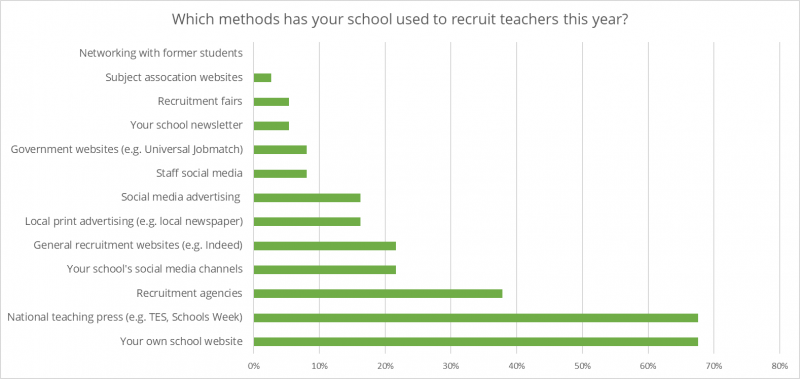- Latest NewsUp-to-date articles giving you information on best practice and policy changes.
- Skills AuditsEvaluate your skills and knowledge, identify gaps and determine training needs.
Rethinking the recruitment journey
Simon Hepburn explains how using a marketing approach will help your school attract and retain the best teachers
Many schools are finding it harder to recruit good teachers, for a number of reasons.
- Fewer teachers than needed are applying for jobs, especially in secondary schools.
- The number of pupils is rising.
- More teachers are leaving the profession.
- Teacher pay is dropping relative to other graduate professions.
The problem is worse in some areas of the country, notably London and the South East; and in some secondary subjects, particularly maths, design and technology and physics. (For more information on these trends read Teacher Workforce Dynamics in England, NFER, 2018.)
The results are clear. Traditional recruitment methods have stopped working – a secondary head I spoke to at the Optimus Effective Financial Management conference said that none of his external advertisements had resulted in a successful recruit this year.
And even if they do yield some result, applicant quality is dropping. A Manchester school I spoke to recently asked a prospective maths teacher from an agency to try a GCSE paper and they scored 0%.
What is the solution?
Stop thinking of recruitment as solely an HR process. This worked in the past when there were more teachers and the challenge was to find the best one from 10, 20 or even more applications. It didn’t matter that all job adverts looked the same or that all interviews took place on the same day.
Now you need to take a marketing approach. There are three key steps.
- Create compelling messages by listening to staff and developing the benefits of your school.
- Use ‘high trust’ channels to target the teachers that are out there.
- Make the application process as easy and convenient as possible.
Doing this means you will be able to take staff through the ‘new recruitment journey’ (see the diagram below) and ensure the future success of your school.

1. Create compelling messages by listening to staff and developing the benefits of your school
Teachers know that they have a wide choice of schools to select from when looking for a new job. That means that they will choose from schools that offer something different to meets their needs.
Your school needs to bring together what it already offers, find what teachers in your area want from schools, and try to add new benefits, considering the financial issues that many schools face. The combination of these key messages is often referred to as an ‘employer brand’.
As an example, teachers often cite professional development as a key issue when looking for work – but as the Marketing Advice for Schools survey shows, few schools offer such opportunities. Could your school implement some of these approaches to help it stand out?

Other areas schools are working on include access to housing, discounts on shopping, flexible working and even ‘duvet days’!
Once you have identified what makes your school different, make sure that this is clearly laid out on your website and other recruitment material – and perhaps backed up with teacher testimonials and even video interviews. If you’re asked to justify the costs of these, think of the cost of even the smallest national advert!
And when you place adverts you must use these messages to focus on what you offer applicants, rather than the all too common focus on what the school needs.
Which is more appealing?
‘We require an outstanding and passionate teacher of maths to start in September 2019. The ability to teach maths at a high standard across the key stages is essential.’
Or:
‘We put professional development at the centre of our work, offer a mentoring programme for all staff, and have a flexible range of benefits including discounted childcare’.
2. Use 'high trust' channels to target the teachers that are out there
There are two groups of teachers who might be willing to work for your school: those who are looking for work (including student teachers) and those who might be tempted to move to a school that was better suited for them.
Traditional recruitment methods focus on the first group – those who read job adverts or have signed up with recruitment agencies. These are ‘low trust’ routes – advertising executives are the least trusted group in the Ipsos Veracity Index and recruitment consultancies are not far behind and only work when there are large number of job-seekers.
The solution is to use ‘high trust’ methods – targeting people who already know your school. For example...
- Engage your existing local community of parents and former pupils
Your local community is a powerful source of contacts who know your school and its strengths. Current parents and former students may also be interested in working or retraining as a teacher themselves. Engage them with job adverts in your weekly newsletter, regular social media posts or by arranging events for former students.
- Which teachers do you already know?
There’s often a reluctance in schools to ask current or former staff to help with job-hunting – but they are often the best source of new recruits. In order for this to work it is vital that people leave on good terms, and that staff are happy with the school!
- Work with local ITT providers
There are a wide range of teacher training organisations – according to the DfE over 80% of the population live within 10 miles of a training provider. Developing relationships with HE institutions, SCITTs and School Direct providers (perhaps by taking on student placements or offering staff as mentors) can give you access to a huge pool of potential recruits.
Unfortunately, as the table below shows, few schools currently use these routes.

3. Make the application process as easy and convenient as possible
‘I’ve already got a job.’
‘I can only manage 1 or two applications a week.’
‘I don’t want to have to tell my current school I’m looking.’
‘I’ve already applied to several schools – let’s see their response first.’
‘I can’t make the advertised interview dates.’
‘I applied to that school last year and they didn’t get back to me.’
The box above shows a number of the common reasons teachers don’t apply to advertised jobs. If you are going to improve the number of applications you receive it’s worth seeing how many of these reasons you can remove. Here are some suggestions.
- Offer an informal visit or telephone call first
Filling in an application form can take several hours. Someone is far more likely to make this effort once they have found a school that they know is interested in them – and meets their needs. Jobseekers can also test if the school is for them before having to admit they’re looking for work when they request time off for an interview.
- Simplify your application form
School application forms haven’t changed for years. While there are some essential parts, it’s worth asking what information you really need to create a shortlist. And the form should be as easy to complete digitally as possible.
- Offer flexible interview dates
The traditional school interview day involves everyone shortlisted turning up at the same time and doing the same activities in rotation around the school. While this might be efficient with lots of applicants, it doesn’t always work for staff with caring responsibilities or outside interests. If you can get back to an applicant quickly and offer an early interview you might also stop them taking a job elsewhere.
- Think about enhancing your job offers
Schools will have to negotiate job offers now rather than just offering a straight ‘M1’ position. If you are recruiting for a shortage subject think about what else you can offer – from pastoral or leadership responsibility to flexible working or a relocation allowance.
- Give feedback to all applicants
Word travels fast in the teaching community – and if you’re the sort of school that is seen to be helpful to applicants (even unsuccessful ones) you will find people more prepared to apply to you.
The table below shows how many schools are not following these ideas – again giving you the chance to stand out!

Further inspiration
- School21 is a free school in Stratford, East London. The careers section of the school website is clear about the benefits of working at the school.
- Inicio is a tutoring company based in Market Harborough. They were finding it difficult to recruit teachers through adverts and agencies so focused on social media and using video to tell their stories.
- Read David Weston's blog post on becoming an employer of choice.
- Download the Marketing Advice for Schools Teacher Recruitment and Retention Survey.
Last Updated:
02 Apr 2019


